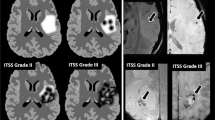Abstract
Susceptibility weighted imaging (SWI) is a newly developed magnetic resonance (MR) protocol. Recent studies have found that SWI may be useful in the field of cerebrovascular diseases, especially for detecting the presence of prominent veins, microbleeds and the susceptibility vessel sign (SVS). Some authors have even suggested that SWI can be used to predict outcome. We conducted a prospective study of patients hospitalized with middle cerebral artery territory infarction receiving MRI within 2 days of stroke onset. The presence of prominent veins, microbleeds and SVS in SWI was analyzed along with hospital characteristics of the patients. A total of 44 patients were enrolled. Among the 44 patients, 15 (34.1%) patients showed prominent veins, 19 (43.2%) showed SVS, and 14 (31.8%) showed microbleeds. The presence of SVS and prominent veins was not associated with prognosis. Though not statistically significant (p = 0.06), patients with SVS were more likely to develop later brain edema. SVS was significantly associated with arterial occlusion (p = 0.008) based on the MR angiogram, and microbleeds were significantly associated with later hemorrhagic transformation (p = 0.018). In our study, SWI could not be used to predict outcome as previously suggested. However, the presence of microbleeds may predict further hemorrhagic transformation, and the presence of SVS could be used to detect intra-arterial thrombus. Patients with SVS were also more likely to develop later brain edema. Including SWI in routine MR protocols for major acute ischemic stroke would be worthwhile.

Similar content being viewed by others
References
Tsui YK, Tsai FY, Hasso AN, Greensite F, Nguyen BV (2009) Susceptibility-weighted imaging for differential diagnosis of cerebral vascular pathology: a pictorial review. J Neurol Sci 287(1–2):7–16
Kesavadas C, Santhosh K, Thomas B et al (2009) Signal changes in cortical laminar necrosis-evidence from susceptibility-weighted magnetic resonance imaging. Neuroradiology 51(5):293–298
Mittal S, Wu Z, Neelavalli J, Haacke EM (2009) Susceptibility-weighted imaging: technical aspects and clinical applications, part 2. Am J Neuroradiol 30(2):232–252
Santhosh K, Kesavadas C, Thomas B et al (2009) Susceptibility weighted imaging: a new tool in magnetic resonance imaging of stroke. Clin Radiol 64(1):74–83
Huang P, Lin WC, Huang PK, Khor GT (2009) Susceptibility weighted imaging in a patient with paroxysmal sympathetic storms. J Neurol 256(2):276–278
Hermier M, Nighoghossian N (2004) Contribution of susceptibility-weighted imaging to acute stroke assessment. Stroke 35(8):1989–1994
Viallon M, Altrichter S, Pereira VM et al (2010) Combined use of pulsed arterial spin-labeling and susceptibility-weighted imaging in stroke at 3T. Eur Neurol 64(5):286–296
Kesavadas C, Thomas B, Pendharakar H, Sylaja PN (2011) Susceptibility weighted imaging: does it give information similar to perfusion weighted imaging in acute stroke? J Neurol 258(5):932–934
Rovira A, Orellana P, Alvarez-Sabín J et al (2004) Hyperacute ischemic stroke: middle cerebral artery susceptibility sign at echo-planar gradient-echo MR imaging. Radiology 232(2):466–473
Schellinger P, Fiebach JB, Hacke W (2003) Imaging-based decision making in thrombolytic therapy for ischemic stroke. Present status. Stroke 34:575–583
Hermier M, Nighoghossian N, Derex L et al (2003) Hypointense transcerebral veins at T2*-weighted MRI: a marker of hemorrhagic transformation risk in patients treated by intravenous tissue plasminogen activator. J Cereb Blood Flow Metab 23:1362–1370
Haacke EM, Xu Y, Cheng YC et al (2004) Susceptibility weighted imaging (SWI). Magn Reson Med 52:612–618
Reichenbach JR, Venkatesan R, Schillinger DJ et al (1997) Small vessels in the human brain: MR venography with deoxyhemoglobin as an intrinsic contrast agent. Radiology 204:272–277
Rauscher A, Sedlacik J, Barth M et al (2005) Magnetic susceptibility-weighted MR phase imaging of the human brain. AJNR Am J Neuroradiol 26:736–742
Tong KA, Ashwal S, Holshouser BA et al (2003) Hemorrhagic shearing lesions in children and adolescents with posttraumatic diffuse axonal injury: improved detection and initial results. Radiology 227:332–339
Thamburaj K, Radhakrishnan VV, Thomas B et al (2008) Intratumoral microhemorrhages on T2*-weighted gradient-echo imaging helps differentiate vestibular schwannoma from meningioma. AJNR Am J Neuroradiol 29(3):552–557
Thomas B, Somasundaram S, Thamburaj K et al (2008) Clinical applications of susceptibility weighted MR imaging of the brain d a pictorial review. Neuroradiology 50:105–116
Tan IL, van Schijndel RA, Pouwels PJ et al (2000) MR venography of multiple sclerosis. AJNR Am J Neuroradiol 21:1039–1042
Flacke S, Urbach H, Keller E et al (2000) Middle cerebral artery (MCA) susceptibility sign at susceptibility-based perfusion MR imaging: clinical importance and comparison with hyperdense MCA sign at CT. Radiology 215:476–482
Moulin T, Crepin Leblond T, Chopard JL et al (1993) Hemorrhagic infarcts. Eur Neurol 34:64–77
Kidwell CS, Saver JL, Villablanca JP et al (2002) Magnetic resonance imaging detection of microbleeds before thrombolysis: an emerging application. Stroke 33:95–98
Fazekas F, Kleinert R, Roob G et al (1999) Histopathologic analysis of foci of signal loss on gradient-echo T2*-weighted MR images in patients with spontaneous intracerebral hemorrhage: evidence of microangiopathy-related microbleeds. AJNR Am J Neuroradiol 20:637–642
Acknowledgment
This study was partially supported by a grant from the Kaohsiung Medical University Hospital-KMUH96-6G-33.
Conflicts of interest
The authors report no conflicts of interest.
Author information
Authors and Affiliations
Corresponding author
Rights and permissions
About this article
Cite this article
Huang, P., Chen, CH., Lin, WC. et al. Clinical applications of susceptibility weighted imaging in patients with major stroke. J Neurol 259, 1426–1432 (2012). https://doi.org/10.1007/s00415-011-6369-2
Received:
Accepted:
Published:
Issue Date:
DOI: https://doi.org/10.1007/s00415-011-6369-2




